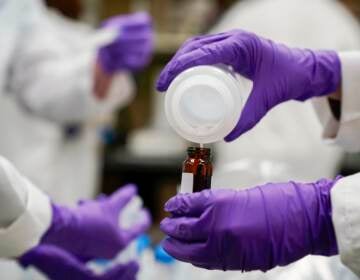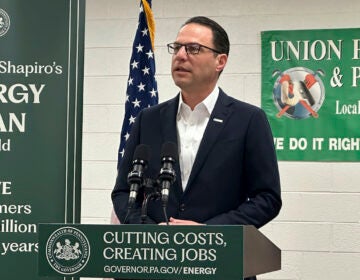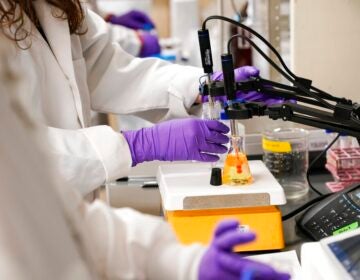DEP to begin statewide sampling for six PFAS chemicals
The year-long program will focus on sources of likely contamination including military bases and airports.

The Horsham Air Guard Station in Bucks County, Pa. where the use of PFAS chemicals in firefighting foam has been linked with contamination of local water supplies. (Jon Hurdle/StateImpact Pennsylvania)
This article originally appeared on StateImpact.
—
Pennsylvania environmental officials said on Friday they will soon begin testing for toxic PFAS chemicals in public water systems near likely sources of contamination including military bases, landfills and factories.
The Department of Environmental Protection said it will sample more than 300 water systems starting in May in a program that is due to last a year.
In a 66-page description of its sampling plan, the DEP’s Bureau of Safe Drinking Water said it aimed to identify known location and potential source of PFAS contamination across the state, assess the risk to drinking water sources, and select public water systems as a control group.
The bureau said it will test for six PFAS chemicals including PFOA and PFOS. It did not name specific locations for sampling but published state maps showing potential water sources for testing, and other places including industrial sites and airports. The map of potential water sources shows a concentration of sites in southeastern Pennsylvania including Lancaster, Berks, Lehigh, Chester, Montgomery, Bucks, Philadelphia and Delaware counties.
A full list of the sampling locations will be published when monitoring is complete, said DEP spokesman Neil Shader. He said the program will not be a comprehensive survey of all public water systems but a “representative sample” to determine the prevalence of PFAS chemicals.
Any system that exceeds the EPA’s health advisory limit will have to confirm its tests and to notify the public, Shader said.
PFAS chemicals have been found in the blood serum of 97 percent of the U.S. population, the plan description said, and in 38 U.S. states including Pennsylvania, although there is “limited occurrence data” in Pennsylvania.
The $250,000 initiative follows Pennsylvania’s announcement in February that it will begin to set its own health limits for PFOA and PFOS. The state announced its plan the day after the U.S. Environmental Protection Agency did not commit to setting national limits as part of a long-awaited “Action Plan” to curb the chemicals.
“DEP will not hesitate to step up when the federal government fails to,” DEP Secretary Patrick McDonnell said in a statement.
In the absence of federal regulation, and amid rising public concern about the chemicals’ risk to public health, some states have set their own strict limits on the most commonly found PFAS chemicals. New Jersey last September became the first state to regulate PFNA, and has recently adopted tough standards on PFOA and PFOS.
Pennsylvania does not set its own limits for the chemicals — which are linked to health conditions including cancer, low birth weights, and elevated cholesterol – but relies on an EPA lifetime health advisory of 70 parts per trillion (ppt) for PFOS and PFOA combined, a level that advocates say is much too lax to protect public health.
On April 15, the Wolf Administration is due to hold the latest public meeting of its PFAS Action Team, a panel of state officials who are charged with investigating the contamination and recommending cleanup strategies.
Some PFAS chemicals were used in consumer products like nonstick cookware and flame-retardant fabrics, starting in the 1940s. Although they are no longer made by U.S. manufacturers, they persist in many public and private water sources because they don’t break down in the environment.
The chemicals have also been used for decades in firefighting foam on military bases such as those near the eastern Pennsylvania town of Horsham, where water systems have been contaminated by PFAS chemicals. Local authorities there have taken their own measures to remove PFAS from water supplies, but local people are still concerned that the bases remain a source of contamination for groundwater.
Delaware Riverkeeper Network, an environmental group that has long campaigned for strict limits on the chemicals, welcomed DEP’s plans to investigate contamination but said the process is already later than it should have been and the plan means it will be two years or more before any maximum contaminant limits on the chemicals are in place.
“We need the sampling data as soon as it can be gathered and compiled so that we will not have to wait another year before DEP proposes maximum contaminant levels for PFAS compounds,” said DRN’s deputy director, Tracy Carluccio. “We needed action yesterday, not years from now.”
In January, the Navy canceled a plan to ship 4,500 tons of PFAS-contaminated soil from the former air station at Willow Grove near Horsham to a landfill in southern New Jersey. The landfill dropped its agreement to take the soil following media reports on the plan.
In 2013-15, the EPA tested for six PFAS chemicals in Pennsylvania as part of a national monitoring program. That sampling included Pittsburgh and Philadelphia, both of which were found to contain PFOA and PFOS below the EPA’s 70 ppt level.
WHYY is your source for fact-based, in-depth journalism and information. As a nonprofit organization, we rely on financial support from readers like you. Please give today.




